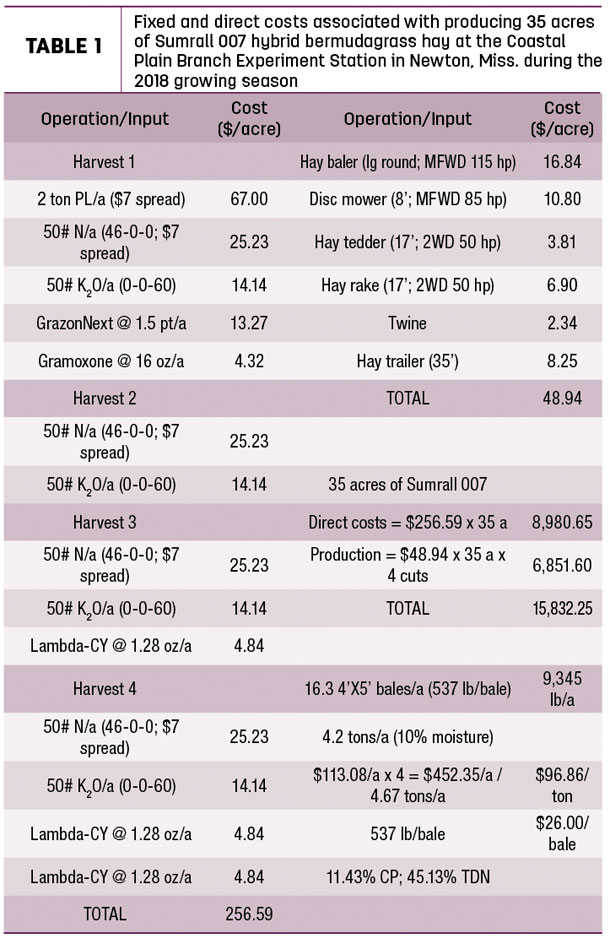This time of year, I begin to get emails and phone calls with these kinds of questions from beef cattle and hay producers. Fortunately, there are plenty of resources out there that allow producers to ballpark all of the costs associated with hay production. Like most land-grant institutions, Mississippi State University has developed enterprise budgets for all of the commodities produced within the state.
For forages, specifically, these budgets are updated every five years, with the most recent version published in 2017. (This excellent download can be found by simply Googling “MSU Forage Planning Budget,” and it should be the first link that pops up, or go to Extension Mississippi State and search for publication 3030.) This report is designed to provide necessary planning data to farmers, research and extension staffs, lending agencies and others in agriculture. It includes production practices, machinery, and estimated direct and fixed costs. Enterprises include hay and pasture production for alfalfa, bahiagrass, bermudagrass (seeded and hybrid), tall fescue, annual ryegrass, small grain and summer annual species with all manner of establishment methods and variables.
Here at the Coastal Plain Branch Experiment Station in Newton, Mississippi, we typically put up around 600 4X5 bales a year on 35 acres of Sumrall 007 hybrid bermudagrass. This is a very similar scenario throughout Mississippi – smaller acreages of dedicated hay ground used to feed an average herd size between 30 to 40 head. The ongoing struggle with these smaller producers is to find economical ways to reduce hay dependency or produce a higher-quality hay, which may result in feeding less (having less waste). With that in mind, I simply wanted to go through our costs associated with hay production this past year with hopes of opening your eyes to some costs you may want to include in this year’s budget.
We had four cuttings in 2018. About 30 days prior to the first cutting, we applied poultry litter at a rate of 2 tons per acre with a $7 spread charge ($30 per ton; Table 1).

Poultry litter is abundant in this part of the state and can be spread fairly cheaply. We also applied commercial nitrogen (N) and potassium (K) to jump-start the stand and generate good yields in that first cutting. (Plus, the more we produce earlier in the year, the less we will have to depend on rainfall later in the year; and the more we have to spray for insects.) We also clean up our fields at this time with a broadleaf and burndown herbicide to control cool-season annual weeds (such as volunteer ryegrass, buttercup and henbit).
For the second harvest, we fertilized with N and K. For the third harvest (July), we observed bermudagrass stem maggot damage (BSM) and decided to make an insecticide application along with a fertilizer application.
For the fourth harvest, two insecticide applications were made: one for BSM and the other for fall armyworms. All of these direct costs totaled $256.59 per acre. The planning budget (referred to earlier) has all of the costs for each product listed in the appendix (fertilizer, herbicide, insecticide, custom rates, etc.).
For operational costs, those can also be found in Table 1. We use a large round baler pulled with a 115-horsepower tractor, an 8-foot disc mower, and a 17-foot tedder and rake. (Each of these implements with estimated purchase price, annual use, useful life, performance rate, and direct and fixed cost per acre can, again, be found in the MSU Forage Planning Budget in the appendix.)
The total for our production was $48.94 per acre. So if you multiply our input costs by the number of acres produced ($256.59 x 35 acres), we ended up spending $8,980.65 on inputs alone.
Our total operational costs were determined by multiplying $48.94 x 35 acres x four harvests = $6,851.60. This leaves us with a grand total of $15,832.25 in total expenses. To break those costs down by ton or bale, we calculated the following: We produced 16.3 4X5 bales per acre (537 pounds per bale) = 9,345 pounds per acre.
If you average input costs over four harvests ($113.08) and divide by tons per acre, our price per ton was $96.86. When divided by the average size of the bale (537 pounds per bale), our total costs in each bale during the 2018 season was $26.
Also, we submit hay and soil samples (which in writing this, I forgot to include as a cost). Our average crude protein was 11.43 percent and total digestible nutrients were 45.13 percent.
These numbers highlight several facets of hay production each producer should be concerned with.
1. Go through your respective production system and determine your operating costs. A lot of producers do not include labor costs because they are the ones often doing the labor – do you work for free?
2. Are the management decisions we are making benefiting us in terms of increased dry matter yield or enhanced nutritive values? Many producers will say, “Why not just cut three times instead of four? This will cut operational costs.” My response would be to ask if they can justify a drop in quality due to longer harvest intervals between cuttings. The importance to knowing how much goes into our hay production is self-explanatory. However, the importance of costs must coincide with good-quality hay in the barn.
3. With increasing insect pressures and drought potential in late-season bermudagrass production in the Deep South, can we afford to not clean our fields up early so as to produce more hay prior to these events taking place? If we don’t sacrifice our first cutting as a “cleanup” harvest and actually produce good-quality hay in the first cutting, will this give us an economic advantage as we progress throughout the year (i.e., produce more earlier, thus potentially not having to spend more on insecticides later)?
4. Finally, I cannot emphasize how important hay testing is. All of these costs are great to know, but if you don’t know the quality of your end product, how good is this information? Can you determine the cost per pound of protein? How many pounds of protein do you need to feed? Energy?
Ultimately, each producer must ask, “Do current practices justify the means to producing my own hay?”
How much is in your bale? ![]()

-
J. Brett Rushing
- Coastal Plain Branch Experiment Station
- Mississippi State University
- Email J. Brett Rushing











